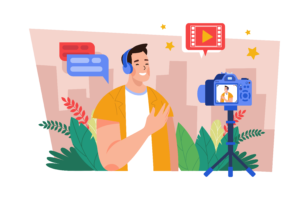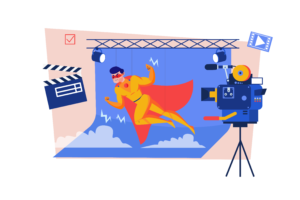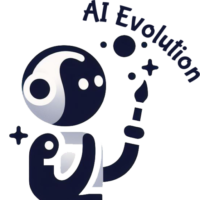Table of Contents

 What is AI?
What is AI?
Alright, let’s dive right in! So, what exactly is AI? In simple terms, Artificial Intelligence (AI) is the replication of human intelligence in machines.
The magic behind the scenes allows computers, robots, and even some of your favorite apps to think, learn, and make decisions like humans.
But instead of neurons and brain cells, AI uses algorithms and data. Imagine teaching a computer to recognize patterns, solve problems, and even understand human language. Sounds like sci-fi, right? But it’s happening right now!
If you’re curious about the nitty-gritty details, Britannica has a fantastic deep dive into the components and applications of AI.AI isn’t just about making machines “think” like humans. It’s about harnessing the power of data and computation to enhance our capabilities.
AI is everywhere, from voice assistants like Siri and Alexa to recommendation algorithms on Netflix or Spotify. And the beauty of it? It’s constantly learning and evolving. Every interaction, every piece of data, helps AI become better, wiser, and more attuned to our needs.
But here’s the thing – AI isn’t just a single technology. It’s a vast field with various branches like Machine Learning, Neural Networks, and Deep Learning, each with unique capabilities and applications.
As we delve deeper into this guide, you’ll get a glimpse of these and understand how they’re shaping the future of content creation and beyond.
 Fun Fact: Did you know that, According to Google CEO Sundar Pichai, artificial intelligence (AI) will have a greater impact on humanity than both electricity and fire? Dive into more such insights over at Valuer.
Fun Fact: Did you know that, According to Google CEO Sundar Pichai, artificial intelligence (AI) will have a greater impact on humanity than both electricity and fire? Dive into more such insights over at Valuer.
 How AI is Revolutionizing Content Creation
How AI is Revolutionizing Content Creation
Okay, we’ve established what AI is, but you might wonder, “How is it changing the content creation game?” Well, let me tell you, the impact of AI on content creation is nothing short of revolutionary.
Gone are the days when creating content meant hours of brainstorming, drafting, and editing. With AI, much of the heavy lifting is done for you. Think of it as having a super-smart assistant who’s always ready to help, whether generating ideas, crafting engaging headlines, or even optimizing content for search engines.
One of the most significant shifts we’ve seen is the rise of generative AI models. These models, like GPT-4, can produce high-quality articles, stories, and more, often indistinguishable from human-written content. And it’s not just about text.
 AI-driven tools can now create stunning visuals, videos, and even music tracks. Imagine having the ability to generate a unique image or video clip based on a simple description. It’s like having a digital artist at your fingertips! And the best part?
AI-driven tools can now create stunning visuals, videos, and even music tracks. Imagine having the ability to generate a unique image or video clip based on a simple description. It’s like having a digital artist at your fingertips! And the best part?
These tools are becoming more accessible and user-friendly, making it easier for content creators of all levels to harness their power. Harvard Business Review has an insightful piece if you’re keen to dive deeper into how generative AI is changing the creative landscape.
But it’s not just about content generation. AI is also playing a pivotal role in content optimization and distribution. With AI-driven analytics tools, creators can gain insights into their audience’s preferences, optimize content for better engagement, and predict future content trends.
It’s a holistic approach, ensuring that the content resonates with the audience and achieves the desired impact.
Statistic: The market for AI in marketing is projected to reach a staggering $107.5 billion by 2028, up from $15.84 billion in 2021. This growth underscores the increasing role of AI in content creation and its potential to reshape the marketing landscape. Curious about what this means for marketers and content creators? Check out this insightful analysis over at HubSpot.
Applications of AI in Content Creation
Now that we’ve covered the AI tools available, you might wonder, “How can I use these in my content creation process?” Well, the applications of AI in content creation are vast and varied. AI is reshaping how we create and consume content, from drafting blog posts to producing videos. Let’s dive into some of the most exciting applications of AI in the content realm.
 Blog posts and articles
Blog posts and articles
One of the most common applications of AI in content creation is in writing. With tools like GPT-4, you can draft articles, generate ideas, and even get suggestions for improving your writing style. AI can analyze your audience’s interests and suggest relevant topics, making it easier to produce content that resonates. Whether struggling with writer’s block or working on a tight deadline, AI can be a lifesaver. For more insights on how AI is revolutionizing blog writing, check out this article by Buffer.
 Social media content
Social media content
Social media is all about engagement, and AI can help you optimize your content for maximum impact. AI tools can streamline your social media strategy, from generating catchy captions to suggesting the best times to post. Plus, with image and video generation tools, you can create eye-catching visuals that stand out in the crowded social media landscape.
 Video scripts and production
Video scripts and production
Producing videos can be time-consuming, but much of the process can be automated with AI. AI tools can help draft scripts, suggest edits, and even generate video clips. Whether you’re creating tutorials, ads, or documentaries, AI can enhance the production process, ensuring you deliver high-quality content every time.
 Graphic design and infographics
Graphic design and infographics
Visual content is crucial in today’s digital age, and AI is making it easier than ever to create stunning graphics. With AI-driven design tools, you can generate infographics, banners, and more tailored to your brand’s aesthetic. No more hours tweaking designs; with AI, you get professional-quality graphics in minutes.

Music and audio content
Believe it or not, AI also waves in the music industry. AI tools are revolutionizing how we create and consume music, from composing tunes to optimizing audio quality. Whether you are a budding musician or a podcast producer, AI can enhance your audio content, ensuring it resonates with your audience.
Fun Fact: OpenAI’s MuseNet, an AI model, can compose music in various styles, from classical to rock. It’s a testament to the incredible capabilities of AI in the realm of music. Dive into the world of AI-composed tunes over at OpenAI.
 Benefits and Challenges of Using AI for Content
Benefits and Challenges of Using AI for Content
There’s a lot to be excited about when using AI for content creation. First and foremost, AI can be a game-changer in terms of productivity. With the right tools, you can automate repetitive tasks, generate content at scale, and even get suggestions for optimizing your content for better engagement. Imagine having an assistant who can help you brainstorm ideas, draft articles, and even fine-tune your writing style to resonate with your target audience. That’s the power of AI. It’s like having a co-pilot guiding you through the content creation process and ensuring you’re on the right track.
But, as with any technology, there are challenges to consider. One of the primary concerns is the potential for AI-generated content to lack the human touch. While AI can produce content based on data and algorithms, it might miss out on the nuances and emotions that only humans can bring. There’s also the ethical aspect to consider. With AI’s ability to generate content at scale, there’s a risk of flooding the market with low-quality, repetitive content. Plus, the ever-present challenge is ensuring that AI-generated content is original and not plagiarized. For a deeper dive into the benefits and drawbacks of using AI tools for content, Forbes has an insightful article on the topic.
Despite these challenges, the potential of AI in content creation is undeniable. With the right approach and a balance between human creativity and AI assistance, content creators can harness the power of AI to produce high-quality, engaging, and impactful content. It’s all about finding the right balance and using AI to enhance, not replace human creativity.
Fun Fact: Did you know AI can now write poetry, compose music, and even paint? While these creations might not have the emotional depth of human-made art, they’re a testament to the incredible capabilities of AI. Dive into the world of AI artistry over at Artsy.
 Types of AI Content Tools
Types of AI Content Tools
With the rapid advancements in AI, many tools are available for content creators. But not all tools are created equal, and each serves a unique purpose. Let’s break down the different types of AI content tools and see how they can elevate your content creation game.
Natural Language Processing (NLP) tools
At the heart of many AI content tools is Natural Language Processing (NLP). These tools are designed to understand, interpret, and generate human language. Think of chatbots, voice assistants, and even some advanced grammar checkers. They analyze text, understand context, and can even generate human-like responses. With NLP tools, you can automate customer support, optimize content for SEO, and even get suggestions for improving your writing style.
Generative models (e.g., GPT-4, BERT)
Generative models are the rockstars of the AI content world. Tools like GPT-4 can produce high-quality articles, stories, and more. They’re trained on vast amounts of data and can generate content often indistinguishable from human-written pieces. Whether you’re looking to draft articles, generate ideas, or even write scripts, generative models have covered you. But remember, while they’re powerful, they still require a human touch to ensure the content resonates with the audience.
Image and video generation tools (e.g., DALL-E, VQ-VAE)
It’s not just about text. AI is making waves in the visual content domain too. Tools like DALL-E can generate unique images based on simple descriptions. Need a picture of a two-headed giraffe wearing sunglasses? No problem! And with tools like VQ-VAE, you can even generate video clips. These tools open up a world of possibilities for graphic designers, video creators, and artists, allowing them to bring their wildest imaginations to life.
AI-driven design and layout tools
Designing layouts for websites, magazines, or digital ads can be time-consuming. But with AI-driven design tools, you can automate much of the process. These tools analyze content, understand the intended audience, and generate aesthetically pleasing and practical designs. Say goodbye to hours of tweaking layouts and let AI handle the heavy lifting. For a deeper dive into some of the best AI content tools available in 2023, check out this comprehensive list at ClickUp.
Statistic: By 2025, it’s estimated that over 50% of content creators will use some form of AI tool in their workflow. This shift underscores the growing importance and reliance on AI in the creative industry. Discover more about the rise of AI in content creation at Gartner.
 Best Practices and Ethics
Best Practices and Ethics
As we embrace the power of AI in content creation, it’s crucial to approach it with a sense of responsibility. While AI offers numerous benefits, it also presents challenges that require careful consideration. Ensuring that our content is ethical, original, and respectful is paramount. Discuss some best practices and ethical considerations when using AI for content creation.
Ensuring originality and avoiding plagiarism
One of the primary concerns with AI-generated content is the risk of unintentional plagiarism. Since AI models are trained on vast amounts of data, there’s a possibility they might produce content that closely resembles existing works. It’s essential to use plagiarism detection tools and always review AI-generated content for originality. Remember, while AI can assist in the creation process, the final responsibility lies with the content creator.
Balancing human creativity with AI assistance
AI is a powerful tool, but it shouldn’t replace human creativity. Think of AI as a co-pilot, assisting and enhancing the content creation process. It’s essential to strike a balance between human input and AI-generated content. This ensures that the content resonates with the audience and retains the human touch, often crucial for emotional connection and engagement.
Ethical considerations in AI-generated content
As with any technology, ethical considerations are paramount. It’s essential to be transparent about the use of AI in content creation. If a piece is entirely AI-generated, disclosing this to the audience is good practice. Additionally, consider the implications of AI-generated content in sensitive areas like news reporting, where accuracy and authenticity are crucial. Harvard Business Review offers a comprehensive guide for a deeper dive into building ethical AI.
Addressing biases in AI models
AI models are trained on data; if this data contains biases, the AI might inadvertently perpetuate these biases. It’s crucial to be aware of potential biases in AI-generated content and take steps to mitigate them. This involves using diverse training data, regularly reviewing AI outputs, and being open to feedback from the audience.
Statistic: A recent survey revealed that 85% of content creators believe ethical considerations are crucial when using AI tools. This underscores ethics’ growing awareness and importance in the AI content creation realm. Discover more about the role of ethics in AI at the World Economic Forum.
 Workflow Integration
Workflow Integration
As AI tools become more prevalent in content creation, integrating them seamlessly into your existing workflow is essential. It’s not just about using a new tool; it’s about maximizing its potential to enhance your content creation process. Let’s discuss how to effectively incorporate AI tools into your workflow and the benefits of doing so.
Incorporating AI tools into your content creation process
Start by identifying areas in your content creation process that can benefit from automation or enhancement. Whether it’s brainstorming ideas, drafting content, or optimizing for SEO, an AI tool can likely assist. Once you’ve identified these areas, research and choose AI tools that align with your needs. Remember, it’s not about replacing your current tools but enhancing them with AI capabilities.
Training and fine-tuning AI models for specific tasks
While many AI tools come pre-trained and ready to use, fine-tuning them for specific tasks is often needed. This ensures that the AI-generated content aligns with your brand voice and audience preferences. Spend time training your AI tools, providing feedback, and refining their outputs. Over time, these tools will become more attuned to your needs, producing content more aligned with your brand’s identity.
Collaborative tools for teams
If you work in a team, consider AI tools that promote collaboration. Many AI content tools offer features like real-time collaboration, feedback loops, and version control. This ensures that everyone on the team can contribute, review, and refine AI-generated content, leading to a more cohesive and high-quality final product. For insights on achieving seamless content automation integration, AIContentfy has a detailed guide.
Fun Fact: Did you know that many top brands now use AI-driven collaborative tools to streamline their content creation process? These tools enhance productivity and foster creativity by allowing teams to brainstorm and refine ideas in real time. Dive deeper into the world of collaborative AI tools at CMSWire.
 Future Trends and Innovations
Future Trends and Innovations
The world of AI in content creation is ever-evolving, with innovations emerging rapidly. As we look to the future, it’s exciting to envision the possibilities and advancements that lie ahead. From more sophisticated AI models to entirely new ways of creating content, the future promises a transformative landscape for content creators. Let’s explore some anticipated trends and innovations in AI content creation.
The evolving landscape of AI in content creation
As AI models become more advanced, we can expect them to produce content that’s even more indistinguishable from human-written pieces. The lines between human and AI-generated content will blur, leading to a more collaborative and integrated content creation process. Additionally, as AI becomes more accessible, we’ll see a surge in its adoption across various industries, from journalism to entertainment.
Potential breakthroughs on the horizon
While tools like GPT-4 and DALL-E are already impressive, the AI community continuously works on breakthroughs that could revolutionize content creation. Imagine AI models that can understand and mimic specific writing styles or tools to produce entire movies based on a simple prompt. The potential is vast, and the coming years will likely witness some groundbreaking innovations in AI content creation.
The role of AI in shaping the future of storytelling and media
Storytelling is at the heart of content creation, and AI is poised to shape its future significantly. With AI’s ability to analyze vast amounts of data, we can expect more personalized and tailored content experiences. Whether it’s a news article that adapts to the reader’s preferences or a movie that changes its storyline based on audience reactions, the future of storytelling will be dynamic and interactive. For a deeper dive into the future of content creation and the role of AI, LinkedIn offers an insightful article on the topic.
Statistic: By 2030, it’s projected that AI will be responsible for creating over 40% of digital content. This shift underscores the growing influence of AI in the content creation industry and its potential to reshape how we consume information. Learn more about the future of AI in content creation at Forbes.
 Case Studies and Real-world Examples
Case Studies and Real-world Examples
While we’ve discussed the theory and potential of AI in content creation, real-world examples provide tangible evidence of its impact. Across industries, brands and creators leverage AI tools to produce innovative and engaging content. These case studies offer a glimpse into the transformative power of AI in the content realm. Let’s explore some success stories and lessons learned from AI-driven content campaigns.
Success stories of brands and creators using AI
Brands across the globe are harnessing the power of AI to enhance their content strategies. From automating content production to personalizing user experiences, AI is a game-changer. For instance, major news outlets use AI to draft articles, especially for data-driven pieces like financial reports. Similarly, e-commerce brands leverage AI to generate product descriptions, reviews, and personalized content for users.
Lessons learned from AI-driven content campaigns
While AI offers numerous benefits, it’s essential to approach it with a strategic mindset. Brands that have successfully integrated AI into their content strategies emphasize the importance of training and fine-tuning AI models. It’s not just about using an AI tool; it’s about ensuring it aligns with the brand’s voice and audience preferences. Moreover, transparency is crucial. Brands that disclose the use of AI in content creation build trust and credibility with their audience.
Innovative uses of AI in various industries
AI’s impact on content creation isn’t limited to traditional sectors like journalism or e-commerce. Industries like healthcare, finance, and entertainment are also exploring the potential of AI. For example, in the healthcare sector, AI is used to draft patient reports, research papers, and informational content. AI tools assist in scriptwriting, movie production, and music composition in entertainment. The possibilities are endless, and the future looks promising. For a comprehensive exploration of real-world applications and case studies, check out this article by AIContentfy.
Fun Fact: The first AI-written script for a short film titled “Sunspring” was produced in 2016. The film, which was created using an AI named Benjamin, garnered significant attention and showcased AI’s potential in filmmaking. Dive deeper into the fascinating journey of “Sunspring” at The Verge.
 Getting Started and Resources
Getting Started and Resources
Embarking on the AI-driven content creation journey can be exciting and overwhelming. With many tools and resources available, knowing where to start and which tools to trust can be challenging. However, with the proper guidance and resources, you can harness the power of AI to elevate your content creation game. Let’s dive into some steps to get started and the resources that can guide you.
Choosing the right AI tools for your needs
The first step in integrating AI into your content creation process is selecting the right tools. Consider your specific needs, whether drafting articles, creating graphics, or generating video content. Research various AI tools, read reviews, and test them to find the best fit. Some popular AI content creation tools in 2023 include ClickUp, Narrato, Lately, Copy.ai, and Synthesia. For a comprehensive list of the best AI content creation tools, ClickUp offers an insightful guide.
Tutorials and courses on AI content creation
Once you’ve chosen your AI tools, investing time in learning how to use them effectively is essential. Many platforms offer tutorials, webinars, and courses to help users get the most out of their AI tools. Whether you’re a beginner or looking to advance your skills, a wealth of information is available to guide you. Platforms like Coursera, Udemy, and Khan Academy offer courses on AI and its applications in content creation.
Communities and forums for AI enthusiasts and content creators
Engaging with a community of like-minded individuals can be invaluable as you navigate the world of AI content creation. Join forums, attend webinars, and participate in discussions to gain insights, share experiences, and learn from others. Websites like Reddit, Stack Overflow, and AI-specific forums are excellent platforms to connect with experts, ask questions, and stay updated on the latest trends and innovations in AI content creation.
Fun Fact: The global AI software market is expected to experience explosive growth, reaching over $100 billion by 2025. This growth is a testament to the increasing adoption of AI across industries, including content creation. Discover more about the rise of AI in the global market at Statista.
Conclusion
As we’ve journeyed through the vast landscape of AI in content creation, it’s evident that we’re on the brink of a transformative era. Integrating AI tools and technologies is not just a fleeting trend; it’s a paradigm shift reshaping how we conceive, produce, and consume content. From automating mundane tasks to generating creative and personalized content, AI is an invaluable ally for content creators.
However, as with any technological advancement, it’s essential to approach AI with a balanced perspective. While it offers numerous benefits, it’s crucial to use it ethically, ensuring originality and authenticity in the content produced. Moreover, continuous learning and adaptation are essential. As AI tools evolve, staying updated and honing your skills will ensure you remain at the forefront of this exciting domain.
As we look to the future, the possibilities are boundless. With continuous innovations and breakthroughs on the horizon, the content creation industry is set for a revolution. Embracing AI today will enhance your content creation process and position you for success in the ever-evolving digital landscape. For a deeper dive into how AI is disrupting the content creation economy, Forbes offers an insightful perspective on the topic.
